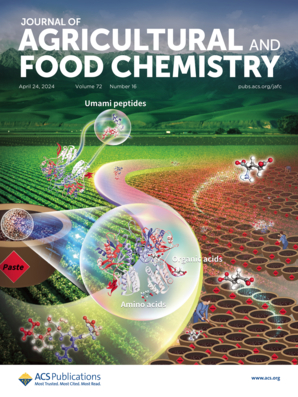Gut Microbiota-Driven Metabolic Alterations Reveal the Gut-Brain Communication of Ergothioneine in Ameliorating Cognitive Impairment in APP/PS1 Mice.
IF 5.7
1区 农林科学
Q1 AGRICULTURE, MULTIDISCIPLINARY
引用次数: 0
Abstract
The pathogenesis of Alzheimer's disease (AD) is complex, and there are currently no effective therapeutic drugs available. Growing evidence suggested that dietary factors may play a vital role in the prevention and mitigation of AD. In this study, we investigated the effects of ergothioneine (ET), administered through drinking water for 6 months, on cognitive impairment in APPswe/PS 1dE9 (APP/PS1) mice. Treatment with ET (40 mg/kg) significantly enhanced cognitive function, reduced neuronal damage, decreased Aβ accumulation, suppressed microglial overactivation, and lowered TNF-α expression in the mouse brain. Moreover, ET treatment partially restored neurotransmitter and chemokine homeostasis in the brain. Notably, ET administration reshaped the gut microbiota of APP/PS1 mice, including increased abundance of Alistipes, Clostridiales_unclassified, and Peptococcaceae_unclassified. ET also enhanced the formation of butyric acid, isobutyric acid, and valeric acid. Serum metabolomic analysis revealed distinct metabolic profiles of APP/PS1 from wild-type (WT) mice, with sphingolipids and glycerophospholipids identified as the most enriched pathways influenced by ET treatment. Correlation analysis elucidated the alterations in gut microbiota networks, contributions of the gut microbiota to short-chain fatty acids and serum metabolic profiles, and mediatory roles of metabolites between the gut microbiota and AD. Altogether, this study elucidated the protective effects of ET on the gut-brain axis in AD, underscoring its potential as an early dietary intervention to improve memory function and alleviate AD symptoms. These findings provide a foundational and theoretical basis for the development of ET-based dietary strategies for AD prevention.肠道微生物群驱动的代谢改变揭示麦角硫因在改善APP/PS1小鼠认知障碍中的肠-脑通讯
阿尔茨海默病(AD)的发病机制复杂,目前尚无有效的治疗药物。越来越多的证据表明,饮食因素可能在AD的预防和缓解中起着至关重要的作用。在这项研究中,我们研究了麦角硫因(ET)通过饮用水给药6个月对APPswe/ ps1de9 (APP/PS1)小鼠认知障碍的影响。ET (40 mg/kg)可显著增强小鼠脑内认知功能,减轻神经元损伤,减少Aβ积累,抑制小胶质细胞过度激活,降低TNF-α表达。此外,ET治疗部分恢复了大脑中的神经递质和趋化因子稳态。值得注意的是,ET重塑了APP/PS1小鼠的肠道微生物群,包括Alistipes、Clostridiales_unclassified和Peptococcaceae_unclassified的丰度增加。ET还促进了丁酸、异丁酸和戊酸的形成。血清代谢组学分析显示野生型(WT)小鼠的APP/PS1代谢谱不同,鞘脂和甘油磷脂被确定为受ET处理影响最富集的途径。相关分析阐明了肠道菌群网络的改变,肠道菌群对短链脂肪酸和血清代谢谱的贡献,以及肠道菌群与AD之间代谢物的中介作用。总之,本研究阐明了ET对AD患者肠-脑轴的保护作用,强调了其作为早期饮食干预改善记忆功能和缓解AD症状的潜力。这些发现为制定基于et的饮食策略预防AD提供了基础和理论依据。
本文章由计算机程序翻译,如有差异,请以英文原文为准。
求助全文
约1分钟内获得全文
求助全文
来源期刊
CiteScore
9.90
自引率
8.20%
发文量
1375
审稿时长
2.3 months
期刊介绍:
The Journal of Agricultural and Food Chemistry publishes high-quality, cutting edge original research representing complete studies and research advances dealing with the chemistry and biochemistry of agriculture and food. The Journal also encourages papers with chemistry and/or biochemistry as a major component combined with biological/sensory/nutritional/toxicological evaluation related to agriculture and/or food.

 求助内容:
求助内容: 应助结果提醒方式:
应助结果提醒方式:


